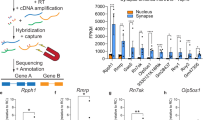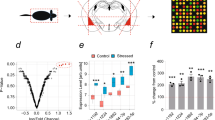Abstract
MicroRNAs are small non-coding RNAs that mediate post-transcriptional gene silencing. Fear-extinction learning in C57/Bl6J mice led to increased expression of the brain-specific microRNA miR-128b, which disrupted stability of several plasticity-related target genes and regulated formation of fear-extinction memory. Increased miR-128b activity may therefore facilitate the transition from retrieval of the original fear memory toward the formation of a new fear-extinction memory.
This is a preview of subscription content, access via your institution
Access options
Subscribe to this journal
Receive 12 print issues and online access
$209.00 per year
only $17.42 per issue
Buy this article
- Purchase on Springer Link
- Instant access to full article PDF
Prices may be subject to local taxes which are calculated during checkout



Similar content being viewed by others
References
Quirk, G.J. & Mueller, D. Neuropsychopharmacology 33, 56–72 (2008).
Guo, H., Ingolia, N.T., Weissman, J.S. & Bartel, D.P. Nature 466, 835–840 (2010).
Lai, E.C. Nat. Genet. 30, 363–364 (2002).
Schaefer, A. et al. J. Exp. Med. 207, 1843–1851 (2010).
Hollander, J.A. et al. Nature 466, 197–202 (2010).
Chandrasekar, V. & Dreyer, J.L. Mol. Cell. Neurosci. 42, 350–362 (2009).
Rajasethupathy, P. et al. Neuron 63, 803–817 (2009).
Gao, J. et al. Nature 466, 1105–1109 (2010).
Rakhilin, S.V. et al. Science 306, 698–701 (2004).
Mueller, D., Bravo-Rivera, C. & Quirk, G.J. Biol. Psychiatry 68, 1055–1060 (2010).
Lauzon, N.M., Bishop, S.F. & Laviolette, S.R. J. Neurosci. 29, 4836–4845 (2009).
Rossato, J.I. et al. Science 325, 1017–1020 (2009).
Baumgärtel, K. et al. Nat. Neurosci. 11, 572–578 (2008).
Lin, C.H. et al. J. Neurosci. 23, 1574–1579 (2003).
Monteys, A.M. et al. RNA 16, 495–505 (2010).
Acknowledgements
We thank P. Greengard and A. Nairn for their comments and the generous gift of RCS antibody, G. Quirk and C. Stevenson for suggestions, and R. Tweedale for editing the manuscript. This work was supported by a scholar award from the Michael Smith Foundation for Health Research (M.S.K.), a US National Institutes of Health EUREKA grant (R01 MH084095, Y.E.S.), and previous grants from the Canadian Institutes of Health Research, the Michael Smith Foundation for Health Research and the National Institute on Drug Abuse (K99DA026503-01), and a current grant from the Australian Research Council (DP1096148, T.W.B.).
Author information
Authors and Affiliations
Contributions
Q.L. conceived the project, prepared the lentiviral constructs, carried out the experiments and wrote the manuscript. W.W. prepared lentiviral constructs, carried out the luciferase assay and quantitative PCR experiments and wrote the manuscript. C.M.C. performed behavioral experiments. X.L. performed behavioral experiments and contributed to in vitro studies. D.B.-A. assisted with the molecular experiments. K.D. contributed to in vitro experiments. V.S.R. performed quantitative PCR studies. Z.B. performed the miR-128bOx behavioral experiments. M.S.K. contributed reagents and helped write the manuscript. Y.E.S. contributed reagents and helped design the experiments. T.W.B conceived the project, designed experiments and wrote the manuscript.
Corresponding author
Ethics declarations
Competing interests
The authors declare no competing financial interests.
Supplementary information
Supplementary Text and Figures
Supplementary Figures 1–13, Supplementary Table 1 and Supplementary Methods (PDF 1461 kb)
Rights and permissions
About this article
Cite this article
Lin, Q., Wei, W., Coelho, C. et al. The brain-specific microRNA miR-128b regulates the formation of fear-extinction memory. Nat Neurosci 14, 1115–1117 (2011). https://doi.org/10.1038/nn.2891
Received:
Accepted:
Published:
Issue Date:
DOI: https://doi.org/10.1038/nn.2891
This article is cited by
-
The effects of the recurrent social isolation stress on fear extinction and dopamine D2 receptors in the amygdala and the hippocampus
Pharmacological Reports (2023)
-
Development of prefrontal cortex
Neuropsychopharmacology (2022)
-
miR-128 as a Regulator of Synaptic Properties in 5xFAD Mice Hippocampal Neurons
Journal of Molecular Neuroscience (2021)
-
Dynamic regulation of Z-DNA in the mouse prefrontal cortex by the RNA-editing enzyme Adar1 is required for fear extinction
Nature Neuroscience (2020)
-
MicroRNA regulation of persistent stress-enhanced memory
Molecular Psychiatry (2020)



